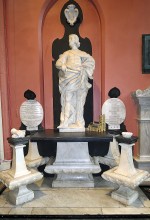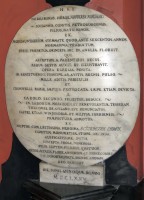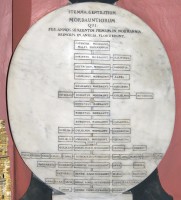
In Fulham Parish Church, in London, is the monument to Lord Mordaunt. The monument as a whole is complex and unusual: the statue of Mordaunt, in Carrara marble, stands upon a black marble table, supported on a thick marble pedestal, rectangular in cross-section, of which the top is not much wider than the base of the statue, giving the appearance that statue and pedestal are one, passing entirely through the table. This base has a widened frame around it, low down, with shell-designs on the lower surface, giving a curious, blocky look to it. Around the table are four thinner pedestals, now narrowed to the point of being almost square pillars, though widening considerably at the point where lie the frames, which are of the same height and thickness as that of the central pedestal. As with the central piece, each corner pedestal has upon it a small, black slab of marble, more a stool than a table top, and each of these bears some further object in white marble. At the front, a small coronet to our right, and to the left, a pair of crossed gauntlets, a splendid touch. To the rear the corner pedestals bear two large oval panels of white marble, raised up vertically. That to the left as we look at the monument has a long Latin inscription to the ‘Noble hero Johannes Mordaunt’; that to the right has an extended family tree covering 17 generations.

 Monument inscription, and family tree of the Mordaunt lineage.
Monument inscription, and family tree of the Mordaunt lineage.
In the centre of this assemblage stands the statue of Mordaunt himself, in front of a shaped black backing to add a dramatic backdrop. The statue is dramatic indeed, with the proud lord looking to one side, posed with one hand, concealed, on his waist, the other holding some scroll or rod. One foot points forward, the other leg stretches to the side, as if the subject has paused in Shakespearian declamation. Mordaunt’s expression is haughty; his sideways glance lets us see his Roman profile, with somewhat hooked nose, hair wavy at the top, ringletted at side and back, clear of the shoulder; he wears no beard. He is wearing some close-fit upper garment, and a short tunic, mostly covered by his great, sweeping cloak, wound over his arms, falling across his lower torso to be swept round behind his legs and hang to the ground, caught up at the rear side on the hilt of his half-seen sword. His legs below the tunic are bare, and he wears soft boots, open at the toes. We should not look too long at the legs, for as well as being rather thin, their anatomy is odd and the length below the knee disproportionate. However, taken as a whole, the monument gives an impression of magnificence which must have been of considerable gratification to the next generation of Mordaunts.
 Mordaunt seen from left side, as if striding towards the viewer.
Mordaunt seen from left side, as if striding towards the viewer.
We are used in our church monuments to see statues which can be seen essentially from the front, but the design of this work, with its figure standing forward from the backing, means that we can view it from a range of angles; it is dramatic from all of them. This remarkable monument is by the sculptor John Bushnell, and such baroque creations are characteristic of his work.
It should be noted that Fulham Parish Church contains an extremely good collection of monuments, some 40 or so in all, and while the Mordaunt is the most impressive, we can see too a range of memorials from 16th through to the 20th Century, with the earlier ones being the most rich in materials and craftsmanship. The pictures of Mordaunt are courtesy of the Church, and please seek their agreement if you would wish to use the pictures on this page. Their website is www.allsaints-fulham.org.uk.
This page was originally part of a 'sculpture of the month' series, for June 2013. Although the older pages in that series have been absorbed within the site, if you would wish to follow the original monthly series, then jump to the next month (July 2013) or the previous month (May 2013). To continue, go to the bottom of each page where a paragraph like this one allows you to continue to follow the monthly links.
London churches // London sculpture // Sculptors // Introduction to church monuments
Visits to this page from 13 Mar 2014: 5,684